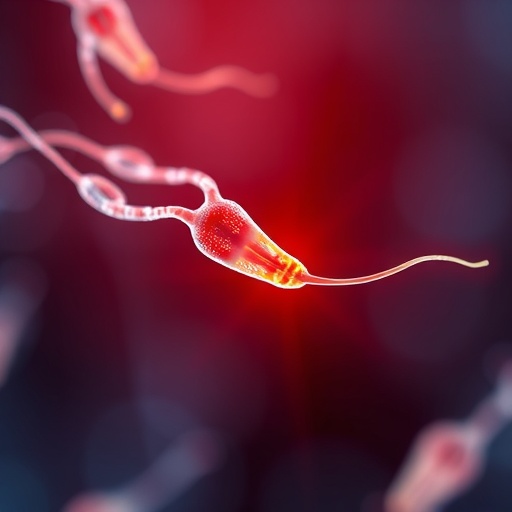In a groundbreaking development from the University of Osaka, researchers have unveiled a critical molecular mechanism underpinning sperm motility, a discovery that sheds new light on male infertility—a condition that affects approximately one in six couples globally. Male factors contribute to nearly half of these infertility cases, often due to defective sperm motility, where sperm fail to swim effectively toward the egg. The study elucidates how the protein TMEM217 operates as a pivotal switch that maintains the driving signal necessary for sperm movement, marking a potential turning point in both diagnostic and therapeutic approaches for male infertility.
Sperm motility is a highly regulated biological process essential for successful fertilization. This motility is driven by the sperm tail, which propels the sperm forward through a finely tuned molecular signaling cascade. Central to this signaling is cyclic AMP (cAMP), a ubiquitous second messenger known to activate numerous cellular responses. Earlier studies established that soluble adenylyl cyclase (sAC) is the enzyme responsible for synthesizing cAMP within sperm cells. However, the exact factors regulating the stability and activity of sAC remained enigmatic, limiting our understanding of how sperm motility is sustained.
The research team directed their focus toward TMEM217, a protein historically uncharacterized but expressed exclusively in testicular tissue. To probe its function, they generated knockout mice lacking TMEM217 expression. These genetically engineered males exhibited complete infertility; their sperm were rendered nearly immotile. This stark phenotype underscored TMEM217’s critical role in male fertility and prompted a deeper molecular investigation into the protein’s interactions within sperm cells.
Further biochemical analyses revealed that TMEM217 forms a stable complex with SLC9C1, a sodium-proton exchanger also known as NHE10, integral to pH homeostasis and ionic regulation. This TMEM217-SLC9C1 complex was found to be indispensable for stabilizing sAC in mature sperm, thereby ensuring sufficient production of cAMP. Absence of TMEM217 led to degradation of SLC9C1, resulting in a dramatic reduction of sAC protein levels. This molecular disassembly precipitated a steep decline in cAMP synthesis, effectively silencing the motility signal and causing sperm to stall.
The pathophysiological consequences of this disruption were profound. Without adequate cAMP, sperm lacked the energy and signaling needed to power their tails, rendering them nearly immotile and incapable of reaching and fertilizing eggs under physiological conditions. This inhibitory cascade provides a compelling explanation for certain types of idiopathic male infertility, where the sperm appear morphologically normal but suffer from functional deficits.
A remarkable aspect of the study was the team’s approach to rescue sperm motility. By treating the immotile sperm extracted from TMEM217-deficient mice with a cAMP analog—a synthetic compound that mimics the effect of cAMP—the researchers could restore motility in vitro. These revitalized sperm regained their swimming ability and successfully fertilized eggs through in vitro fertilization protocols. Subsequent embryo transfer led to the birth of healthy, fertile offspring, indisputably demonstrating the functional recovery of sperm motility and fertilizing capability.
This experimental treatment highlights the therapeutic potential of targeting the TMEM217-SLC9C1-sAC axis in human male infertility cases characterized by similar motility defects. The study suggests that pharmacologically modulating this pathway could restore fertility without the need for more invasive reproductive technologies, offering a beacon of hope to countless couples grappling with unexplained infertility.
Beyond its clinical implications, this discovery refines fundamental cell biology regarding sperm function. TMEM217’s role as a molecular scaffold stabilizing components essential for cAMP signaling represents a nuanced layer of regulatory control previously unappreciated in gamete physiology. The TMEM217-SLC9C1-sAC complex ensures a sustained cAMP signal, maintaining sperm motility through the critical stages leading to fertilization.
Experts regard this finding as a pivotal advance, given the complexity of intracellular signaling required for sperm function. The study elegantly connects membrane proteins involved in ion exchange and signal transduction with enzymatic activity central to motility control. This integrative perspective provides fertile ground for future research into other unexplained reproductive disorders and broadens the horizon for novel fertility treatments.
Professor Masahito Ikawa, the senior author, emphasized the translational aspect of their work, stating, “We pinpointed a simple way to restart immotile sperm by adding a cAMP analog. It’s an encouraging step toward practical options for some forms of male infertility.” This sentiment underscores the blend of basic science and translational research that characterizes this breakthrough, from molecular mechanisms to potential clinical applications.
The implications of this research also extend to evolutionary biology and reproductive ecology, highlighting how sperm motility regulation is finely tuned by molecular complexes that ensure reproductive success. Understanding these control points provides insight into species-specific fertility and may inform conservation strategies or animal breeding programs.
Published in the prestigious Proceedings of the National Academy of Sciences, this study represents a collaborative effort supported by multiple scientific bodies, including the Japan Society for the Promotion of Science, Japan Agency for Medical Research and Development, and international foundations. Its publication marks a significant milestone in reproductive biology, with the potential to influence future diagnostic criteria and therapeutic pathways.
Overall, this discovery not only unravels a previously unknown molecular relationship critical for sperm motility and male fertility but illuminates a new frontier in the fight against infertility. By targeting the TMEM217-SLC9C1-sAC pathway, researchers have opened avenues for novel treatments capable of restoring fertility in cases once deemed untreatable.
Subject of Research: Animals
Article Title: Formation of a complex between TMEM217 and the sodium-proton exchanger SLC9C1 is crucial for mouse sperm motility and male fertility
News Publication Date: 13-Oct-2025
Web References: http://dx.doi.org/10.1073/pnas.2516573122
Image Credits: The University of Osaka
Keywords: Life sciences, Human physiology, Developmental biology, Sperm, Reproductive disorders, Infertility, Intracellular signal transduction
Tags: adenylyl cyclase role in reproductionbreakthroughs in infertility researchcyclic AMP in sperm cellsdiagnosing sperm motility issuesmale infertility treatmentmale reproductive health solutionsmolecular signaling in spermsperm motility mechanismstherapeutic implications for infertilityTMEM217 protein functionunderstanding sperm swimming behaviorUniversity of Osaka research advancements





